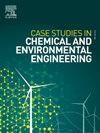制革厂剃须粉尘为基础的木炭混合吸附剂的有效重金属修复:实验和机器学习方法
Q1 Environmental Science
Case Studies in Chemical and Environmental Engineering
Pub Date : 2025-07-01
DOI:10.1016/j.cscee.2025.101256
引用次数: 0
摘要
制革厂剃须粉尘(TSD)是制革厂废弃物之一,由于其可获得性和致癌性引起了人们的极大关注。本研究的重点是利用该废物作为吸附剂处理废水中的重金属。通过将聚乙烯醇(PVA)与TSD中的活性制革剃须粉(AsD)和改性木炭(MC)粉末交联,制备了聚乙烯醇-AsD-MC复合吸附剂(PAsMc),用于去除合成废水中的砷、铬、锌和铅。在这里,PVA-AsD(1:10)与2:3 MC混合具有足够的活性位点,这是由FT-IR保证的。作为吸附剂,PAsMc表现出比AsD更强的热稳定性,其表面形貌高度粗糙。此外,批量实验还考虑了pH、吸附剂剂量和接触时间等因素,获得了令人印象深远的金属去除率:As去除率为98.86%,Cr去除率为99.45%,Zn去除率为99.72%,Pb去除率为98.30%。最佳条件为吸附剂用量为4.0 g/L,搅拌时间为25 min,搅拌速度为300 rpm, pH为8.0 ~ 9.0。吸附等温线和动力学模型为表面化学吸附提供了良好的结果。值得注意的是,这些数据集随后用机器学习模型进行了增强,特别是随机森林(RF),旨在预测HMs的去除。训练集和测试集的R2值分别在0.9927 ~ 0.9984和0.9940 ~ 0.9975范围内,RMSE分别为0.9622 ~ 1.4612和1.1125 ~ 1.9294。最后,建立了一种去除HMs的预测模型,这将有助于PAsMc在废水处理中的合理应用。本文章由计算机程序翻译,如有差异,请以英文原文为准。

Tannery shaving dust-based charcoal blended adsorbent for efficient heavy metal remediation: An experimental and machine learning approach
Tannery shaving dust (TSD) is one of the tannery wastes, poses significant concerns due to its availability and carcinogenic properties. This study has focused on utilizing this waste as adsorbent for heavy metals (HMs) treatment in wastewater. By crosslinking polyvinyl alcohol (PVA) with activated tannery shaving dust (AsD) from TSD and modified charcoal (MC) powder, a composite PVA-AsD-MC adsorbent (PAsMc) was fabricated to remove As, Cr, Zn and Pb from synthetic wastewater. Here, PVA-AsD (1:10) blended with 2:3 MC has sufficient active sites that were ensured by the FT-IR. As an adsorbent the PAsMc showed more thermal stability than AsD, and surface morphology was observed as highly rough. Moreover, the batch experiments have considered pH, adsorbent dose, and contact time factors, achieving impressive metals removal efficiencies: 98.86 % for As, 99.45 % for Cr, 99.72 % for Zn, and 98.30 % for Pb. The optimal conditions were identified as an adsorbent dosage of 4.0 g/L for 25 minutes, and an agitation speed of 300 rpm at pH 8.0–9.0. The adsorption isotherm and kinetics model provided an auspicious result for chemisorption adsorption on the surface. Notably, these datasets were then enhanced with the machine learning model, specifically the Random Forest (RF), aimed at predicting the removal of HMs. The R2 values for the training and testing dataset within the range of 0.9927–0.9984 and 0.9940–0.9975 with a RMSE value of 0.9622–1.4612 and 1.1125–1.9294, respectively. Ultimately, a predictive model for HMs removal was developed, which will assist in making rational applications of PAsMc in wastewater treatment.
求助全文
通过发布文献求助,成功后即可免费获取论文全文。
去求助
来源期刊

Case Studies in Chemical and Environmental Engineering
Engineering-Engineering (miscellaneous)
CiteScore
9.20
自引率
0.00%
发文量
103
审稿时长
40 days
 求助内容:
求助内容: 应助结果提醒方式:
应助结果提醒方式:


